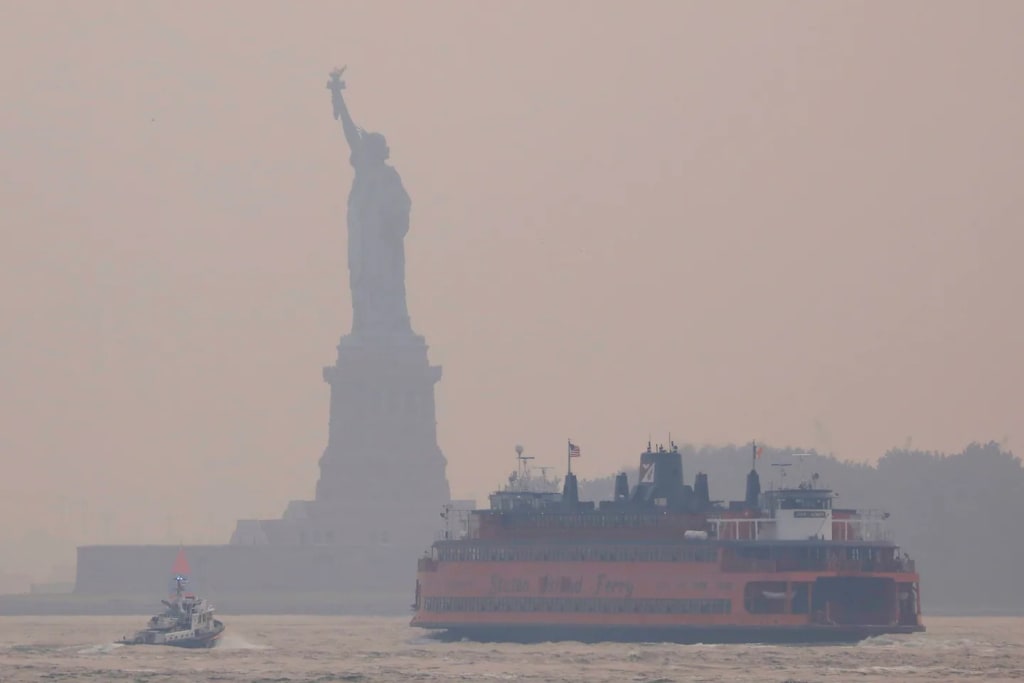Wildfire Smoke Cloaks New York in a Haze
Harnessing Artificial Intelligence for Mitigation

Introduction:
As New York City grapples with the pervasive haze of wildfire smoke, it is essential to explore innovative solutions that can aid in mitigating the impact of these natural disasters. Artificial Intelligence (AI) emerges as a powerful tool that can contribute to wildfire management, prevention, and smoke mitigation efforts. This article delves into the potential applications of AI in combating wildfires and addressing the challenges posed by the smoke that engulfs cities like New York.
Early Detection and Fire Prediction:
AI algorithms can analyze vast amounts of data, including satellite imagery, weather patterns, historical fire data, and topographical information, to detect and predict the occurrence of wildfires. By identifying potential fire hotspots, authorities can take proactive measures to prevent the spread of fires and mitigate their impact.
Smoke Dispersion Modeling:
AI-driven smoke dispersion models can simulate the movement and dispersion of wildfire smoke. By assimilating real-time data such as weather conditions, air quality readings, and terrain information, these models can help predict the trajectory of smoke plumes and their potential impact on populated areas. This information enables authorities to issue timely warnings and guide evacuation plans, ensuring the safety of affected communities.
Air Quality Monitoring and Alerts:
AI-powered sensor networks and monitoring systems can continuously assess air quality during wildfire events. These sensors can detect harmful particles and gases present in the air, providing real-time data on pollutant levels. AI algorithms can process this data to generate alerts and advisories, enabling authorities to inform the public about potential health risks and recommend appropriate protective measures.
Drone Technology and Firefighting:
Drones equipped with AI algorithms and advanced sensors can be employed for real-time monitoring and firefighting operations. These autonomous or remotely operated drones can swiftly navigate through hazardous environments, collect data on fire behavior, and transmit valuable information to incident commanders. AI algorithms can analyze the collected data to optimize firefighting strategies, such as identifying the most effective areas for deploying resources or predicting fire progression.
Smart Emergency Response Systems:
AI-based emergency response systems can aid in coordinating resources and managing evacuation procedures during wildfire events. By analyzing real-time data from multiple sources, such as traffic patterns, population density, and fire dynamics, AI algorithms can optimize evacuation routes, allocate resources efficiently, and provide critical information to first responders and affected communities. This ensures a coordinated and effective emergency response, minimizing the impact on human lives and infrastructure.
Post-Fire Restoration and Risk Assessment:
AI can also play a crucial role in post-fire restoration and risk assessment. By analyzing satellite imagery and ground-level data, AI algorithms can assess the extent of damage, evaluate vegetation recovery, and identify areas at high risk of future wildfires. This information aids in the prioritization of restoration efforts, resource allocation, and long-term planning to mitigate future fire incidents.
Data Analytics and Pattern Recognition:
AI algorithms can analyze vast amounts of historical wildfire data to identify patterns and trends. By understanding the underlying factors that contribute to the ignition and spread of wildfires, AI can help identify high-risk areas and develop targeted prevention strategies. This includes assessing factors such as land use patterns, vegetation health, and human activities that may increase the likelihood of wildfires. By leveraging AI-driven data analytics, authorities can make informed decisions and allocate resources effectively to prevent and mitigate wildfires.
Predictive Maintenance of Firefighting Equipment:
Maintaining firefighting equipment is crucial to ensuring effective response during wildfire events. AI-powered predictive maintenance systems can analyze real-time data from sensors embedded in fire trucks, hoses, and other equipment to detect potential issues before they cause equipment failures. By predicting maintenance needs and optimizing equipment performance, AI can help firefighters maintain operational readiness, enhancing their ability to combat wildfires efficiently.
Public Awareness and Education:
AI can contribute to public awareness and education campaigns aimed at wildfire prevention and safety. Natural language processing and machine learning algorithms can analyze social media data to understand public sentiment, identify misinformation, and deliver accurate information to the public. AI-powered chatbots and virtual assistants can provide real-time responses to frequently asked questions, offering guidance on wildfire prevention measures, evacuation procedures, and protective measures during smoke events.
Collaboration and Knowledge Sharing:
AI-powered platforms can facilitate collaboration and knowledge sharing among scientists, researchers, and policymakers working on wildfire management. These platforms can aggregate and analyze data from various sources, enabling experts to share insights, exchange best practices, and collaborate on developing innovative solutions. By fostering collaboration, AI can accelerate the advancement of wildfire research and promote more effective strategies to combat wildfires and manage their smoke.
Conclusion:
The growing threat of wildfires and the smoke they produce necessitates innovative approaches to mitigate their impact. Artificial Intelligence presents a powerful ally in combating these challenges. By leveraging AI technologies for early detection, smoke dispersion modeling, air quality monitoring, firefighting operations, emergency response systems, and post-fire assessment, we can enhance our capabilities to mitigate the effects of wildfires and protect our communities. As the wildfire crisis persists, harnessing the potential of AI becomes increasingly critical in safeguarding our cities, health, and environment from the devastating consequences of wildfire smoke.
About the Creator
Frank Odhiambo
Frank Odhiambo is a seasoned and passionate writer renowned for his compelling and thought-provoking pieces. Global award winner for "Voice of reason" He has established himself as a prominent voice in the world of authors and writers.
Enjoyed the story? Support the Creator.
Subscribe for free to receive all their stories in your feed. You could also pledge your support or give them a one-off tip, letting them know you appreciate their work.






Comments
There are no comments for this story
Be the first to respond and start the conversation.